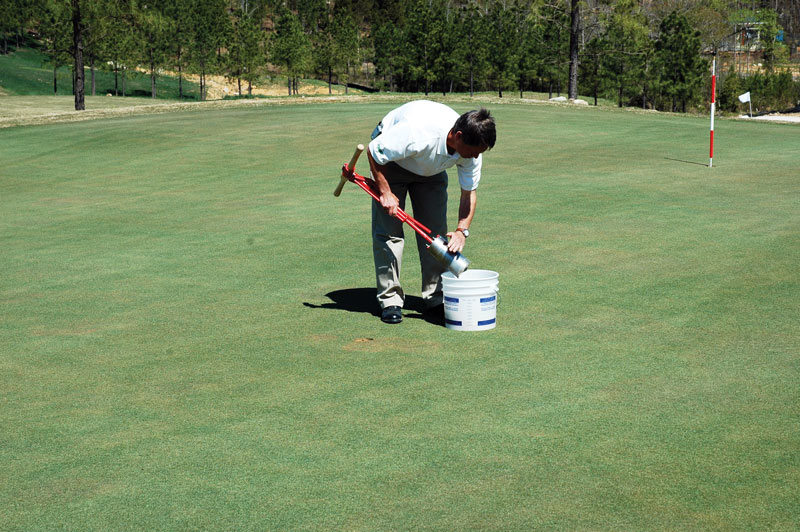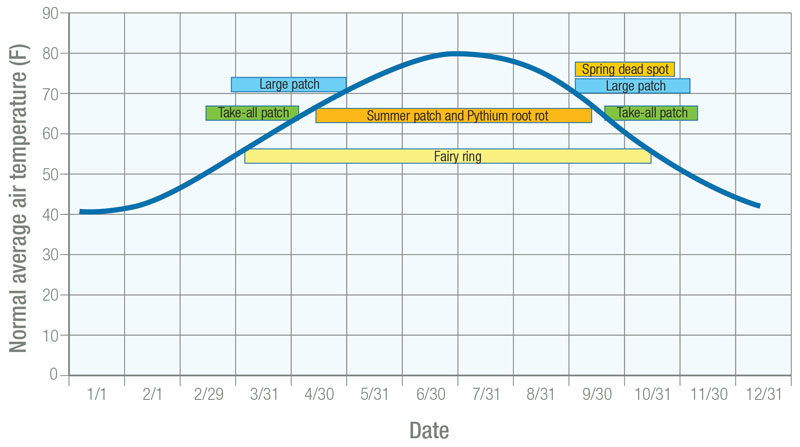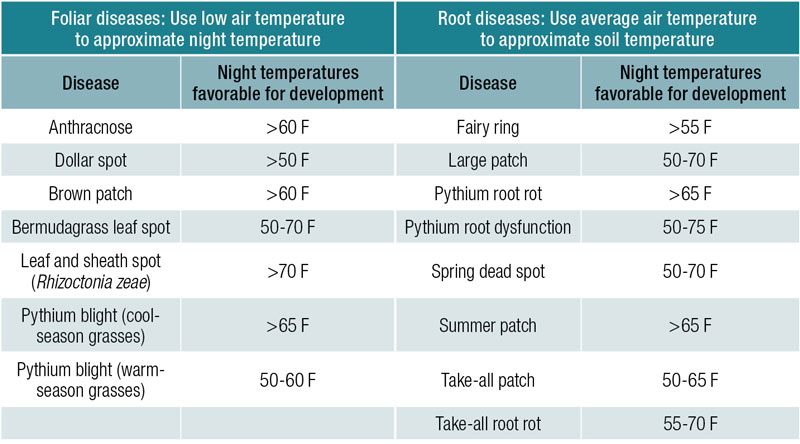
Gather the materials needed to collect and ship diagnostic samples during the off-season so it can be done efficiently when the need arises. Photo courtesy of Syngenta
“I don’t believe in philosophies. I believe in fundamentals.” — Jack Nicklaus
Any good coach will tell you that the game of golf is built on an essential set of skills. Mastering fundamentals such as a good grip, a steady swing and precise putting are the building blocks for success.
For golf course superintendents, the same mentality can be applied to creating a successful turf management strategy. Asking yourself questions such as “Am I treating for the right pests at the right time?” can help build a strong foundation for agronomic planning. That question is particularly important when developing a greens management strategy, because greens are the most prone to damage from diseases, insects and nematodes, and their tolerance for this type of stress is pretty much zero.
Developing an agronomic program for your greens may seem more complicated than ever. With new chemistries, premix products, resistance management concerns and other challenges, it’s enough to make your head spin. But like any other complex task, if you go back to the fundamentals, it becomes far easier to tackle.
To develop a solid greens agronomic program, you need to answer four key questions.
- What pests do I need to prevent?
- What temperatures or other conditions trigger this pest?
- When do those conditions normally occur in my area?
- What product or tank mix will prevent the spectrum of pests expected to be active during each week of the season?
It’s just that simple. OK, maybe it needs some more explanation.
Target the right pests
Once upon a time, you didn’t really need to know exactly which diseases or insects you were targeting with a particular application. Products covered a very broad spectrum, and chances were good that you could pick a product off the shelf and it would take care of the problem. Those days are over. By virtue of their reduced impacts on the environment, newer chemistries are generally more specific to certain pests or a group of pests, so you need to know which pests are targeted by every application.
The first and most important step is to ask yourself, “Which pests do I need to prevent?” This is actually the hardest part of writing a program and a step that many turf managers mistakenly skip.
Every grass species used for greens — from annual bluegrass to zoysiagrass — has a finite list of pests that are regular problems in a given region. But there are a lot of myths and misconceptions here, based mostly on old information published in outdated textbooks. For example, many superintendents with bentgrass greens in the transition zone make preventive applications for take-all patch and Pythium blight, when they should probably be more worried about summer patch and Pythium root rot. Awareness of specific differences can be the tipping point between success and failure.
This is where you should rely on pathology or entomology specialists, Extension specialists, or consultants. Their knowledge of turf pests improves every year, and they are on the cutting edge of the science that can help you pinpoint exactly which pests are problematic in your area. Additionally, you should pay particular attention when turf scientists talk about new or emerging pests at educational conferences. Even if you haven’t seen that new pest yet, you probably will in the near future, and it pays to ensure your program accounts for that.
After you have your list of pests, you should determine what temperatures are conducive to the development of each pest. Take into consideration average daytime and nighttime temperatures, soil temperatures, and how specific pests are influenced by rainfall or humidity. Again, make sure you’re relying on the most up-to-date research available in your area — not your turf pathology textbook that was published in 1982.
Properly time treatments
Whoever first said, “There’s no such thing as a normal year” was probably a golf course superintendent. Compared with low-maintenance areas, intensively managed turf can be very susceptible to weather changes and extremes, which can lead to frequent pest outbreaks or damage from abiotic stresses such as heat and drought that require intervention or management.
Although every year is different, you still need to have a plan going into the season. So how do you time your applications for the coming year? Based on what you’ve always done? Based on what the weather did last year?

Figure 1. Normal average air temperatures are a good approximation for soil temperatures and can be used to predict when root pathogens will become active. Similarly, normal low temperatures can be used to identify when foliar diseases typically become active in your area.
Although there’s no such thing as “normal,” it can be argued that normal temperatures are the best guide we have for planning purposes. In the meteorological world, “normal” has a very specific meaning — it’s the 30-year average temperature or precipitation for a given day, month or year. Normal weather data take into account what happened last year, without overreacting to it, and also account for long-term changes in weather patterns that may occur over time (Figure 1, above).
Many state climate offices have normal weather data available, and the NOAA National Centers for Environmental Information has data available for many locations across the U.S. Normal low temperatures are most useful for foliar diseases, which tend to be most active at night (Table 1, below). Although normal soil temperature data are rarely available, normal average daily temperatures are a good substitute for predicting root and soil-borne pests, especially in sandy soils, which tend to mirror air temperature very closely.
Normal rainfall data can also be useful, especially if you live in a climate that has pronounced wet and dry seasons, such as southern Florida. Foliar diseases are generally less active during dry seasons even though the temperatures may be in their favorable range.

Table 1. Commonly used temperature thresholds for important turfgrass diseases.
Once you have your list of pests, the conditions that favor them and normal weather data for your location, writing an agronomic program becomes a lot easier. Then, plug in products or tank mixtures that will control the spectrum of pests expected to be active for each week. And by rotating chemistries and using products like multisite contact fungicides, you can target key pests while combating resistance management issues.
In your planning, you may find that your traditional timing for treating certain pests is off. For example, many turf managers begin brown patch programs too late or make spring dead spot applications too early, based on historical application dates that are no longer valid.
So, how do you select the best product for each application? You probably just read the label, right? But rather than relying solely on a label, you should also research product performance based on the latest available trial data. This information is available from many universities, including the University of Kentucky and North Carolina State University, as well as some product manufacturers.
Be flexible
Building an agronomic plan is often compared to building a house and the importance of having a solid foundation. However, houses are permanent structures that aren’t easy to change. Perhaps something built with Legos is a better analogy. While the structure is solid, it is also easy to modify as conditions and needs change. Even the best program will have to be modified based on actual weather conditions throughout the season. Some applications may need to go earlier or later if temperatures are warmer or cooler than normal. This is where you need to be in tune with the specific weather conditions that trigger each pest problem so you can modify the program as needed.
Test; don’t guess
Even with the most solid agronomic plan, challenges can always arise. When an unusual symptom is spotted on the turf, often the first instinct is to grab something off the shelf to spray and get the problem fixed ASAP. If you know what the problem is and how to fix it, that’s great. But how confident are you in the real cause of the issue? Seventy-five percent? Fifty percent? Twenty-five percent? If you’re being honest, you may be on the lower end of that spectrum most of the time.
You may get lucky and pull the right product off the shelf, and the problem will go away. However, you still don’t know what the problem was, or, more importantly, how to prevent it from recurring next year. Maybe the problem went away on its own, but now you think the product you sprayed was the correct solution. And if you chose a product that wasn’t the strongest option for that particular pest, you may need more applications to keep it from coming back, further increasing the cost of control. If you manage problems by guessing, there’s no way to improve and refine your program over time. Instead, your program will become a series of guesses that may work in some years but not others.
Submitting samples for proper diagnosis is the best thing you can do to take the guesswork out of agronomic planning. Sample diagnoses provide you with real data you can use to select the best curative treatment and modify your program to prevent the same problem next year. Additionally, as with human medicine, some complex issues may even require a series of tests and take more than one trip to the doctor. Find a diagnostic lab that will work with you over time to get to a definitive diagnosis. Avoid labs that simply provide an inventory of all the pathogens that were identified under a microscope or that grew on a petri dish — this doesn’t tell you what’s actually causing the problem.
Finding the time to collect and submit samples can be a challenge in the midst of a busy season. However, with some prep work, it takes only a few minutes to collect and ship a sample. During the off-season, take time to gather boxes, packing materials, sample submission forms and shipping labels to speed up the process. You can even set up an account with some labs ahead of time to facilitate payment.
At least half the samples submitted to diagnostic labs aren’t a disease issue, which is often the first assumption. There are myriad abiotic stresses, cultural issues and other pests, such as nematodes, that can cause turf to decline. Don’t be disappointed if the lab tells you there’s no disease — that’s good news! However, if you still don’t have a diagnosis, you may need to submit soil and tissue samples for nutrient analysis or nematode samples to rule out other possibilities. Identifying a problem is often a process of elimination, so the more things you can rule out, the closer you are to a definitive diagnosis.
It’s often said that golf course management is a combination of art and science. That was and always will be true. But there was a time when pest management was mostly art and very little science. With the specificity of today’s chemistries, the risk of resistance development and the cost of a wasted application, pest management needs to become more science and less art. Fortunately, the hard work of university scientists and crop protection R&D specialists is making that more possible every year.
So, when you’re developing your agronomic plan, take advantage of all available resources. Listen to the science, monitor your course, and work with your local territory or technical services manager. By following a few basic steps and focusing on the fundamentals, you can ensure you’re combating the right pests with the right products at the right time.
Author’s note: Always read and follow label instructions. Some products may not be registered for sale or use in all states or counties, and/or may have state-specific use requirements. Check with your local Extension service to ensure registration and proper use.
Lane Tredway, Ph.D., is the Southeast technical service representative for turf and landscape at Syngenta and a 28-year veteran of the turfgrass industry.